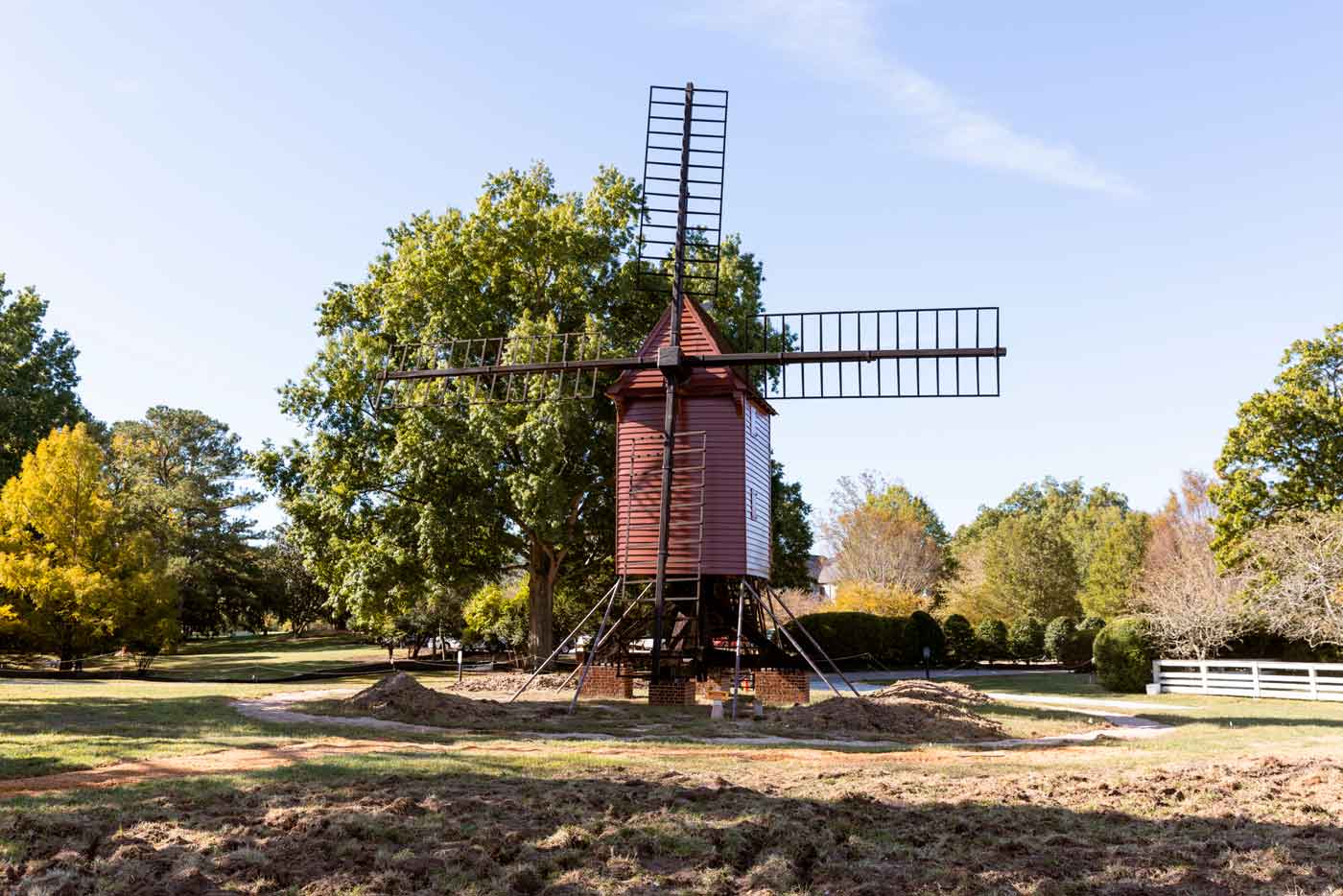Colonial Williamsburg’s windmill, designed and built between 1955 and 1957, is a reconstruction based on the 1636 Bourn windmill in Cambridgeshire, England. Since its completion in 1957, countless Colonial Williamsburg staff have been involved in the preservation and maintenance of this structure. Unlike the homes and public buildings in Colonial Williamsburg’s Historic Area, it requires additional attention given that it is a machine with moving parts. Starting in 2010, the preservation department along with Historic Trades embarked on a more thorough restoration of the mill. Since that time, the mill has moved from the Peyton Randolph House site to the Great Hopes Plantation. Recently it has been returned to the Historic Area at a site off Francis Street adjacent to Ewing House. I spoke with Steve Chabra, Preservation Special Project Supervisor, about his experience working with the mill. We also discussed a bit about the history of milling, millwrights, and carpenters, and how this mill came to be built at Colonial Williamsburg. Read on to learn more.
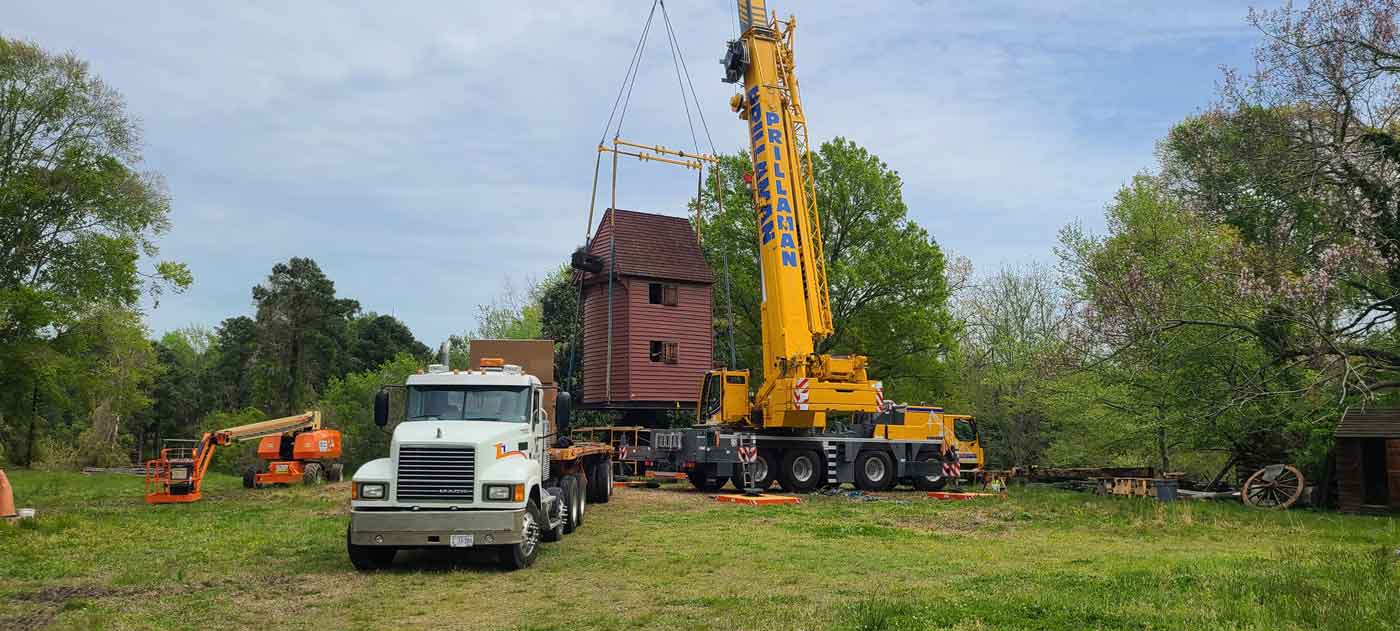
Emily Campbell: You were involved with the restoration of the mill when it was moved to Great Hopes Plantation. What was the greatest challenge with that project?
Steve Chabra: I got involved with the windmill in 2010, when they were preparing to dismantle it at the Peyton Randolph House site and move it to Great Hopes Plantation. The cross trees and quarter bars (part of the foundational trestle) were rotten and needed to be replaced. The Historic Trades carpenters were approached to prepare the timbers. It may sound like an easy task to turn one tree into a 20-foot-long 12'x12' board, but we were asked to make six 20-foot-long 12'x12' boards. Each one took three carpenters one week to process. After we processed the materials to replace the crosstrees and quarter bars, I asked to be part of the team that would be responsible for restoring the mill.
The original plan was to move the mill to Great Hopes Plantation and restore it within a month. After a structural assessment was completed, it was determined there was no way it could be reassembled quickly because major repairs to the structure were needed. The windshaft (wooden hub) was rotten and needed to be completely replaced. The trestle also needed to be rebuilt from scratch, due to wood rot. Before any work could begin, research had to be conducted to understand what repairs were necessary and how to approach the work.
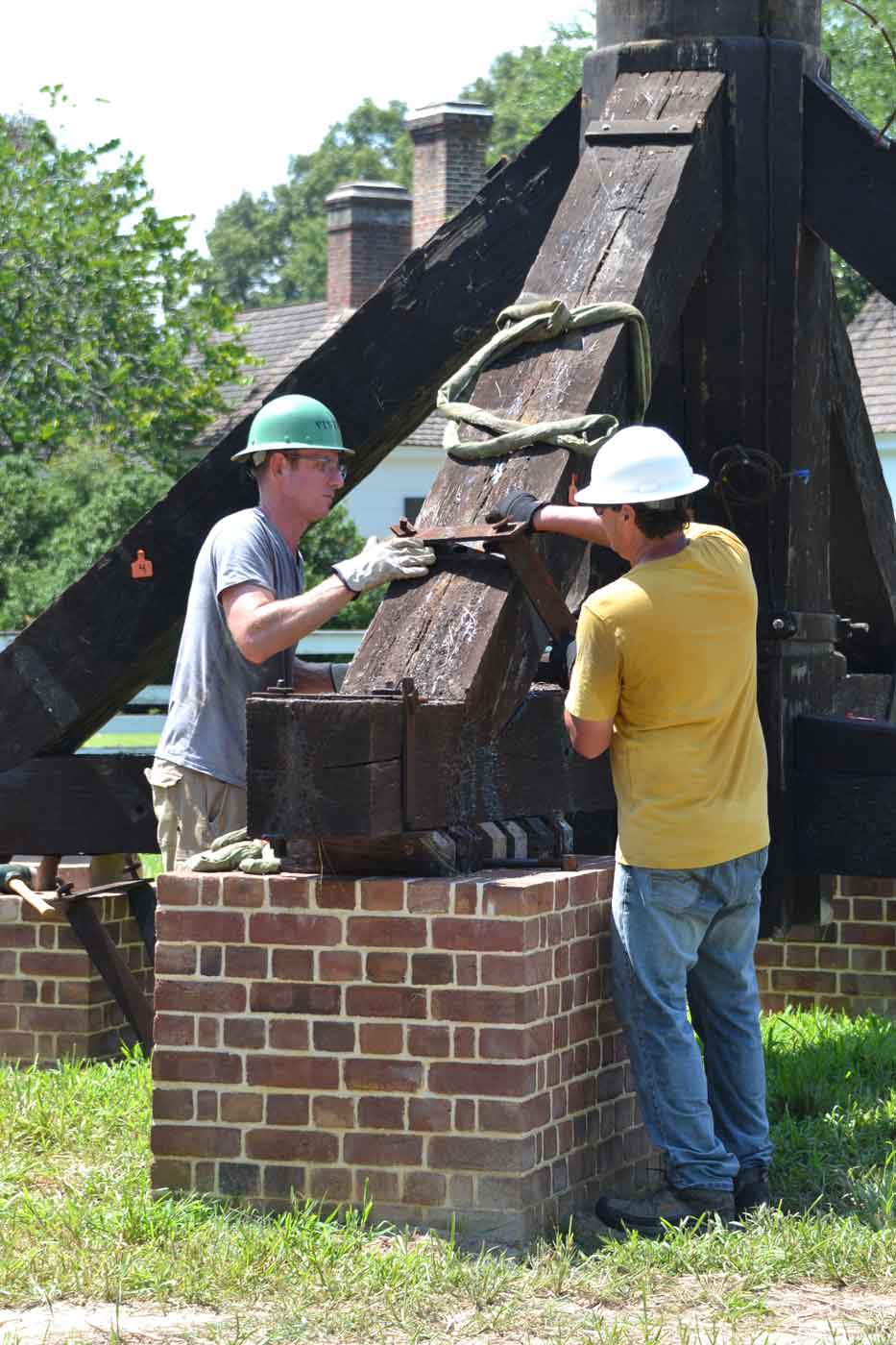
Emily: Were you looking at the repairs from a historical perspective or modern techniques?
Steve: Both, though Colonial Williamsburg’s mill is based on a historic design, the structure itself exists in the modern world. During the eighteenth century a mill would be cared for by a miller, who would constantly do day-to-day maintenance work to keep the mill operational. The miller would also be on the lookout for any problems that would require a millwright to keep the machine running correctly. In the absence of a miller, I needed to find ways to balance the mill’s needs with that of my other projects. I did this by incorporating some modern tools and techniques when possible.
Emily: Did you reach out to people more familiar with windmills?
Steve: Yes, I had reached out to millwrights and mill experts in England. They helped me understand the work that needed to be done. I also went through the Colonial Williamsburg corporate archives and found reports from the seventies and eighties on mills. We eventually reached out to Ben Hassett, a millwright, who does this type of work all over the United States. He came to Colonial Williamsburg, and we were able to work together to help make repairs to the mill.

Emily: What was an important takeaway from working directly with a millwright? What did you learn from this process?
Steve: The most important thing I learned from Ben is the difference between a miller, a millwright, and a carpenter, and how their skills differ and how they overlap. The miller runs the mill. The millwright is responsible for the heavy work of constructing the machine. Carpenters are woodworkers skilled in joining and other woodworking techniques.
Emily: How would a millwright approach it differently than a carpenter? What is a good example?
Steve: Something I learned about a millwright's work is that the timber used to construct a mill needs to be properly seasoned, meaning dry. This is because wood shrinks as it loses volume, which could cause the structure to lean or the machinery to become misaligned. At a minimum, you need to season it for 4 to 5 years to ensure it is stable enough and no longer shrinking to do the joinery. For example, a 12'x12' timber will remain the same length, but it loses mass as it dries. This can tighten or loosen the joints. If the great post shrinks, it loses mass which means the joints will loosen and the upper portion of the mill will begin to lean. It could lean in any direction so this will cause problems with turning the millhouse and having good stability during operation. This whole structure is part of a complex machine. Everything works together from the brick foundation all the way up to the sails.
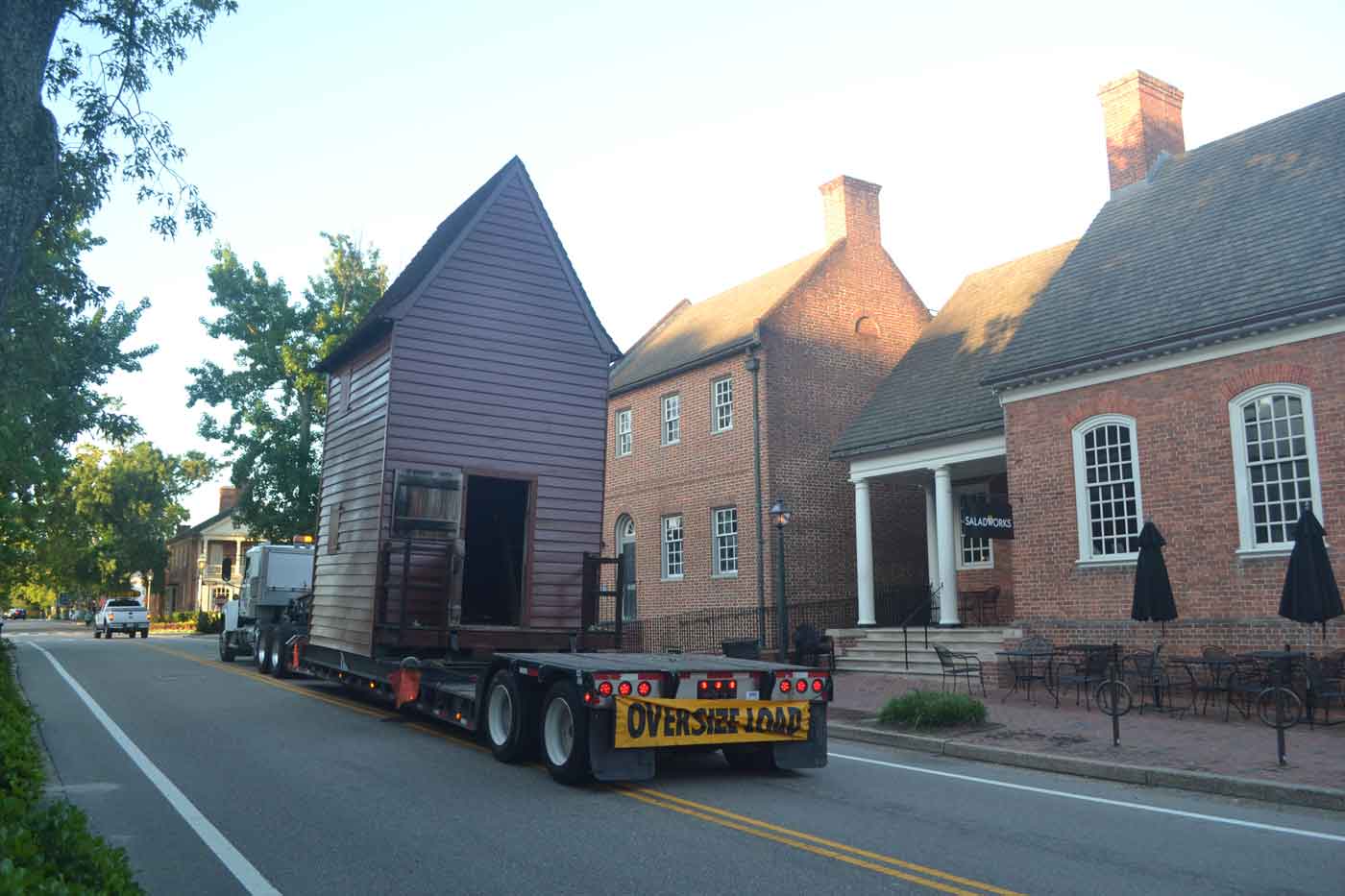
Emily: So even though we talk about this structure like it is a building, it is more a machine than a building?
Steve: It is best to think of our mill as a machine and not a building. A machine requires much more specialized care than a typical building. You can compare a mill to a car. If you do not run and service your car regularly, it will eventually break down.
Emily: What is something about this structure that you would like people to know when they visit?
Steve: This windmill was based on the Bourn mill in Cambridgeshire, England. Bourn mill was chosen because of its small scale and early date of 1636. Most existing eighteenth century post mills are twice this size, if not larger. This means our mill is about as simple as a post mill can be, using technology from the seventeenth century.
When our mill was designed, it was meant to interpret William Robertson’s windmill that was listed in a deed from the 1720s. Therefore, the Bourn mill was a good fit for the project due to its early date. Something to keep in mind is that mill technology progressed during the eighteenth century. By the last quarter of the eighteenth century, mills had become very advanced. One of the most notable changes from the early to the late eighteenth century is the mill’s sails. Some would call the sails on our mill “artist sails,” implying that they look like the sails in paintings. However, this is misleading. In fact, our sails are correct for an earlier style mill derived from seventeenth century examples. Other advancements of the late eighteenth century and early nineteenth century is the use of cast iron gears, and the design of sails became more advanced allowing mills to operate during slower windspeeds.
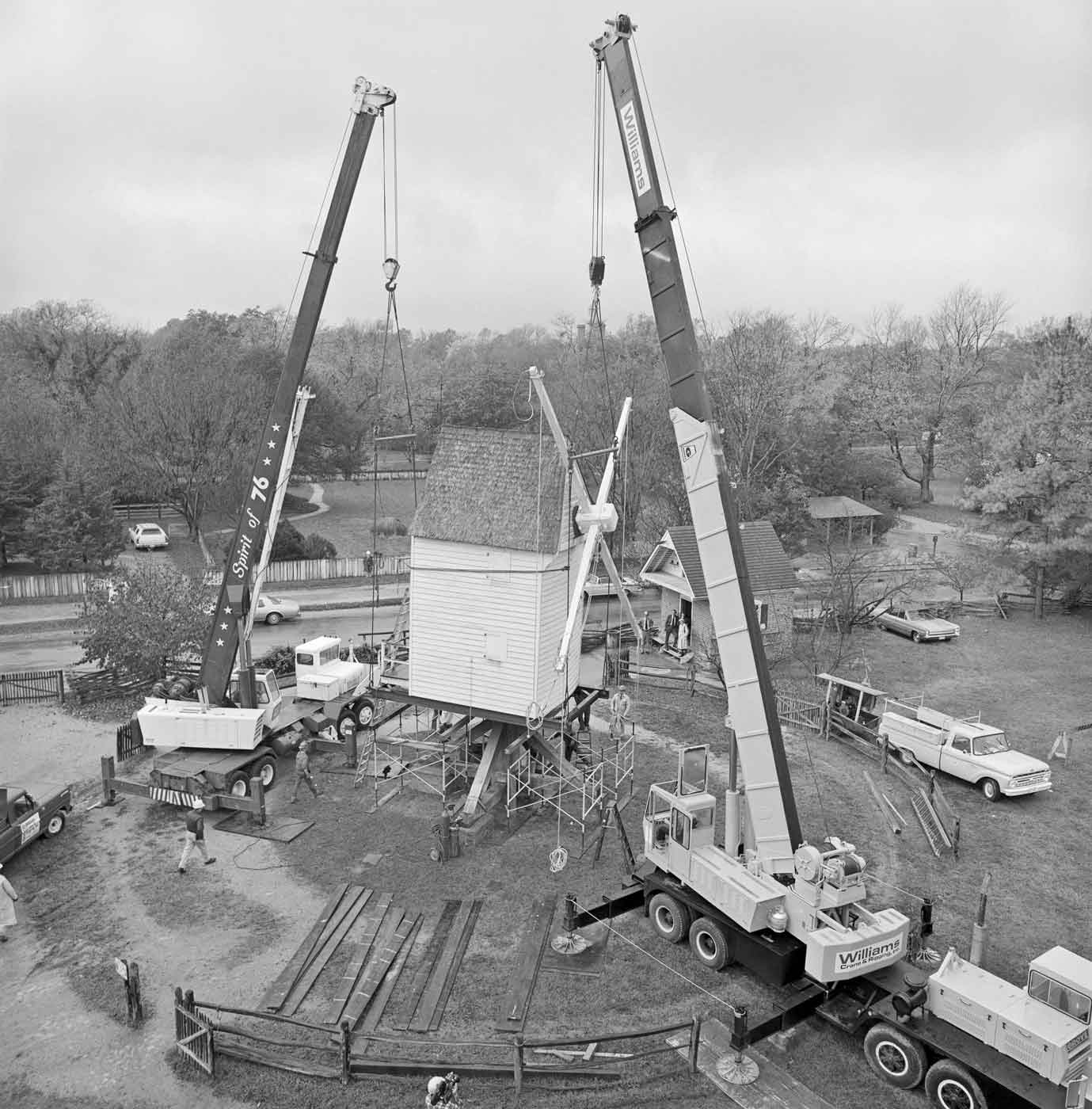
Emily: How would this mill fit into the community during the eighteenth century?
Steve: There are distinct types of mills: toll mills and merchant mills. Local farmers would bring their grain to local toll mills, and the miller would provide milling services for a percentage of the grain for payment. With merchant mills, however, the mill owner would buy massive quantities of grain and mill it for export. Our mill would be considered a toll mill. It is intended to serve the local community, not for mass production.
Emily: Why a post mill? How does it turn and why is it important that it can be turned?
Steve: The first windmills in the western world were post mills, going back to antiquity. Slightly later two additional types of mills were developed: the smock mill and the tower mill. Our mill has a vertical post that goes up into the millhouse. The crown tree is a horizontal 24x24 timber that supports the weight of the mill. The vertical post has a round tenon that is morticed into the crown tree, which allows the entire millhouse to be rotated into the direction of the wind. If wind is your means of power, the miller would not want to lose a day's work because the wind was blowing in the wrong direction. It is necessary to be able to change the position of the mill. Balance is the biggest issue. The mill stones need to be balanced to grind successfully. Post mills tend to lean. If they lean to the front, it is called head sick, and if they lean to the rear, it is called tail sick. If the mill is off balance, the bed stone (bottom stone which is in a fixed position) will lean with the mill and the top stone will no longer make good contact and the grinding will not be efficient.
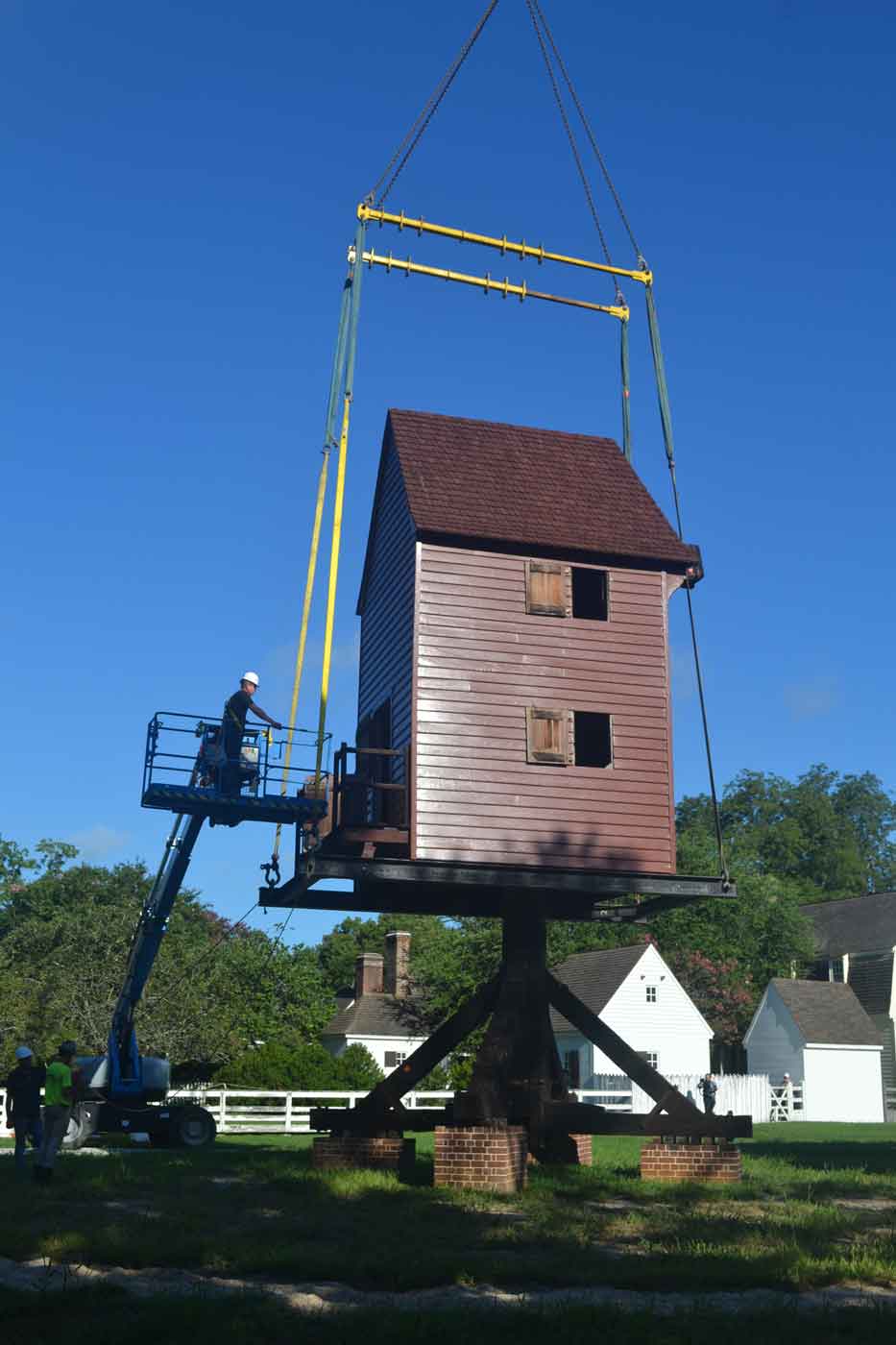
Emily: And the other two forms of mill can rotate?
Steve: For both smock mills and tower mills, the cap or the very top, can be rotated into the wind. Only with post mills does the entire millhouse rotate.
Emily: So, you have fewer issues with balance with the other mill types?
Steve: Yes, with smock and tower mills, all the mechanics are in the part of the structure that does not rotate so it is easier to keep it level and true.
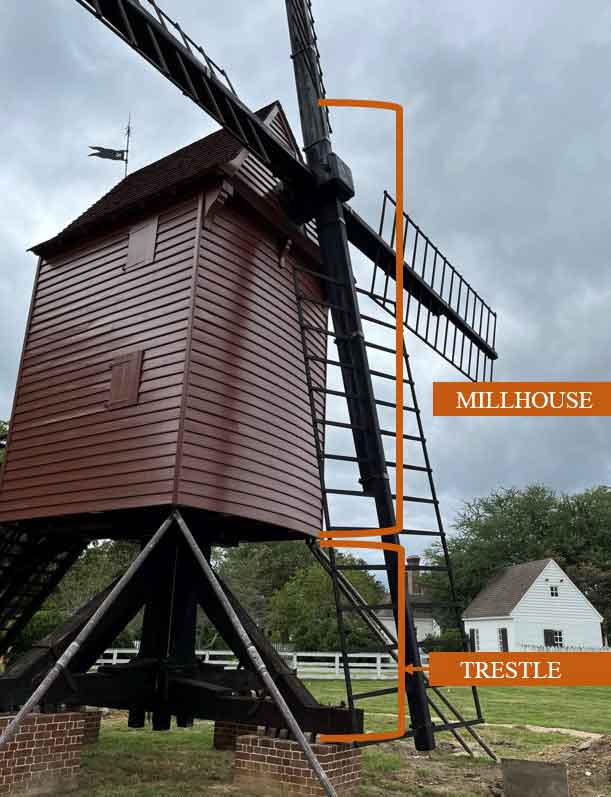
Emily: You mentioned the mill stones. Can you give a brief overview of the mechanism inside the mill since that is not accessible to visitors?
Steve: The mechanisms that power the mill stones are above the stones. This is different than water powered grist mills where the mechanisms are below. Inside the millhouse, you have a brake wheel that is connected to the windshaft (hub that is seen on the exterior). Then you have a wallower gear that contacts the brake wheels teeth (like a gear). The wallower gear turns the top stone. The corn would be in a hopper (shoot) above the stones. The shoot is controlled by vibration and gravity, so essentially the movement of gears shakes the corn into the stones. The corn goes into the hole at the center of the stones. As they turn, the stones crush and tear the kernels and the centripetal force pushes the corn meal out of the sides of the stones and up against the stone housing, called furniture. When enough meal is pushed up against the housing, it is forced into a shoot to the first floor where a sifter separates the fine flower from course meal. The miller would control the mill from the first floor.
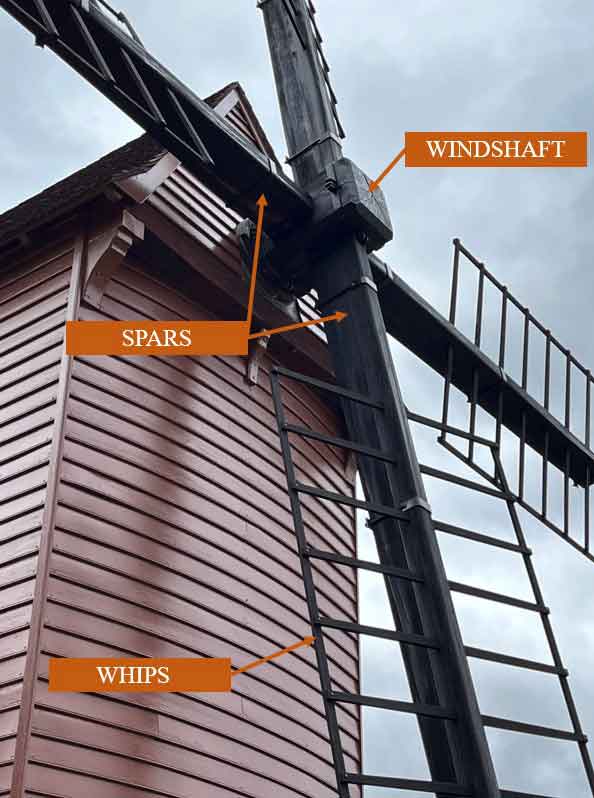
Emily: How about the mechanics we can see on the exterior of the building?
Steve: This mill has a wooden windshaft. The spars are the long pieces made from heart pine that are mortised through the hub. Attached to the end of the spars are the whips. The whips can be described as the wooden frames that the canvas sails are stretched over. Each of the frames gets two runs of canvas. They are tied at each end with rope.
Emily: Is there a strategy for attaching the canvases?
Steve: They are adjustable for wind speed. There are two sails on each whip, at low windspeeds both sails would be unfurled, at high speeds only one might be used. Our mill operates most efficiently at windspeeds at or above 15 miles per hour.
You can also restrict the speed by pouring more corn into the stones. This creates friction and slows down the sails.

Emily: What are the preservation challenges with this structure going forward?
Steve: Wood deterioration is the biggest issue with the windmill. Large timbers do not respond as well to paint because it only protects the surface, it does not soak into the wood. Untreated wood is vulnerable to the elements. Additionally, large timbers expand and contract as they age and season throughout the year which causes checks and splits in the wood. This creates new crevices for water to settle. In the past we had filled the splits with epoxy which works for a while but does not stop wood rot, it is a temporary fix.
I have been using natural wood preventives including pine tar and linseed oil. I got the pine tar idea from talking to the English millwrights and milling consultants. The original Bourn mill is covered in coal tar, bitumen. Since we cannot use this product, we tried to find something that would achieve the same effect. We are approaching this more like a sailing vessel, where they use natural products like pine tar, oakum, and linseed as wood preservatives to keep these vessels afloat. These products are water resistant and help preserve the wood. This is an innovative approach to preserving the timbers on the windmill and we are monitoring the condition to see how well this process is working.
Emily: Are there resources that you recommend for people to learn more about mills, milling, and millwrights?
Steve: The best resource is Mill News published by the Society for the Protection of Ancient Buildings mill section, in England.
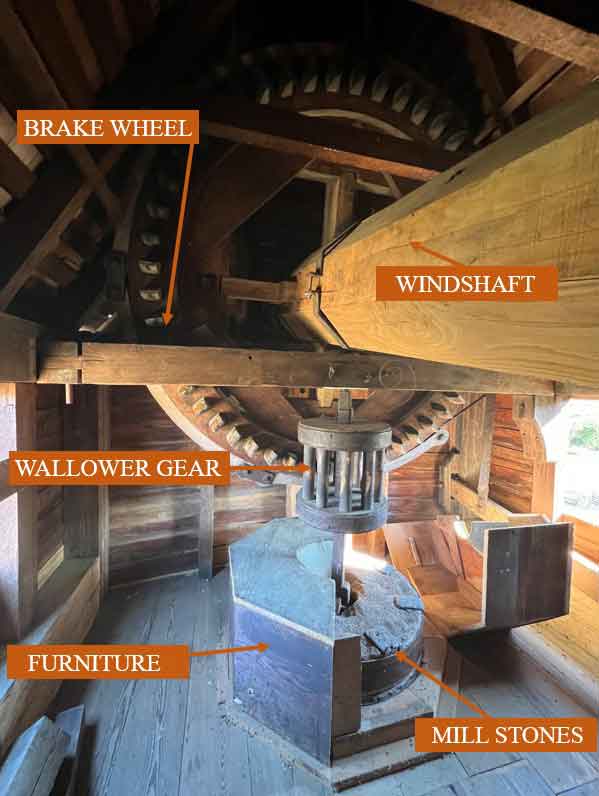
Emily: What was your greatest takeaway from this project?
Steve: After working on the restoration, I feel a great responsibility toward its continued stewardship. Hundreds of Colonial Williamsburg staff have been involved with the construction, maintenance, and preservation of this structure over the years. It is important to protect as well as build on the work of those who came before us.
Emily Campbell is the Architectural Preservation and Research Associate, and she works alongside her colleagues to document and preserve the buildings in the Historic Area.
Steve Chabra is the Preservation Project Supervisor. He has many years of experience as a carpenter, and he is responsible for overseeing the work on all major preservation projects.
Colonial Williamsburg is the largest living history museum in the world. Witness history brought to life on the charming streets of the colonial capital and explore our newly expanded and updated Art Museums of Colonial Williamsburg, featuring the nation’s premier folk art collection, plus the best in British and American fine and decorative arts from 1670–1840. Check out sales and special offers and our Official Colonial Williamsburg Hotels to plan your visit.
